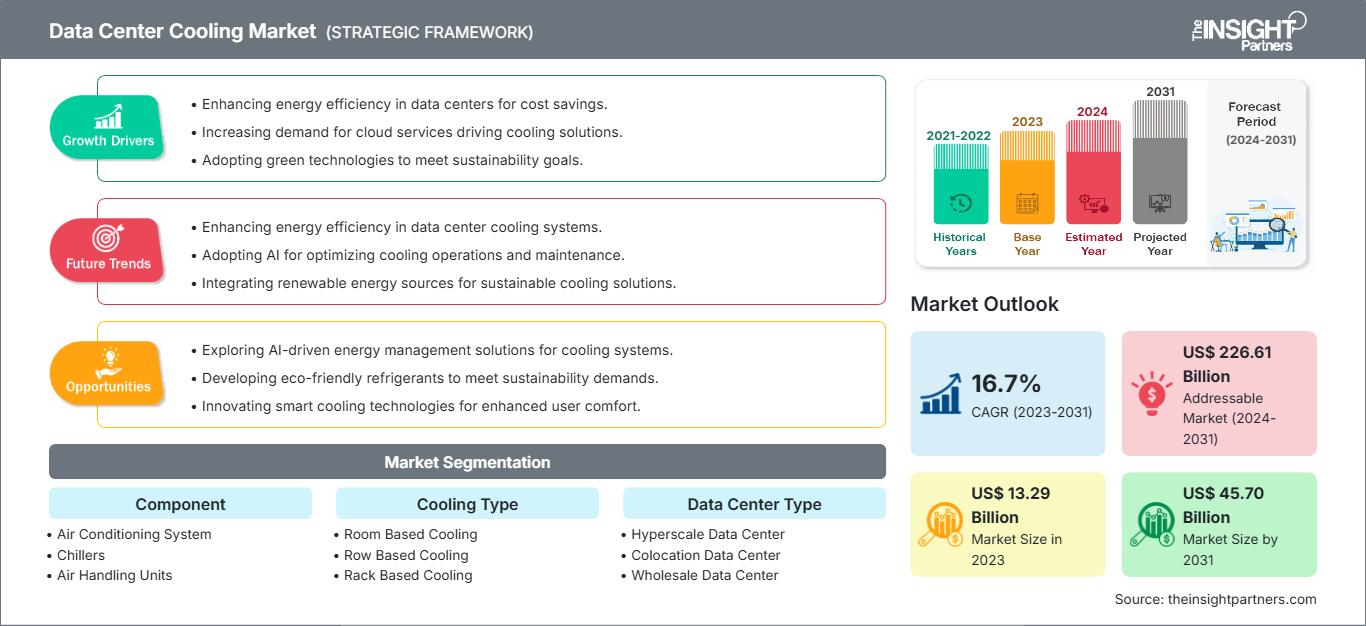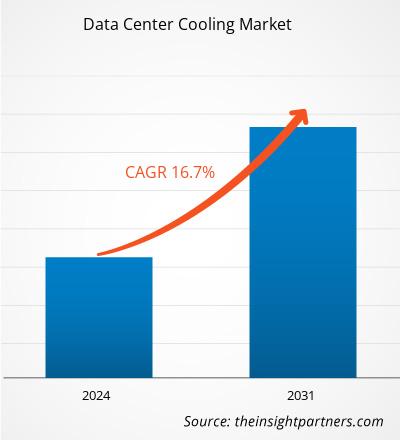数据中心冷却市场规模预计将从 2023 年的 132.9 亿美元增至 2031 年的 457.0 亿美元。预计该市场在 2023 年至 2031 年期间的复合年增长率为 16.7%。人工智能优化的冷却和更安静的冷却解决方案可能会为市场带来新的趋势。
数据中心冷却市场分析
对计算密集型工作负载的需求增加和对数据中心的高投资推动了数据中心冷却市场的发展。市场还见证了高性能计算 (HPC) 的更多使用,这促进了对数据中心冷却解决方案的需求。此外,各大公司采取的战略举措不断增加,例如英特尔公司与 Submer 合作开发高热设计功率 (TDP) 芯片冷却解决方案,也促进了市场的增长。此外,对节能和强大的数据中心冷却解决方案的需求不断增长,再加上互联网、云计算的日益普及;以及人工智能、物联网和大数据等技术预计将推动数据中心液体冷却的普及。由于液体冷却技术的进步和数据中心冷却机器人的兴起,预计市场在预测期内将实现增长。
数据中心冷却市场概览
数据中心冷却是指用于维持数据中心内部最佳温度以确保IT设备正常运行的系统和技术。IT设备在运行过程中会产生热量,而极端高温会导致设备故障。为了克服这些挑战,对数据中心冷却的需求迅速增长。冷却系统对于维护数据中心基础设施的可靠性和性能至关重要。数据中心冷却在为数据中心内所有设备创造和维持最佳运行条件方面发挥着至关重要的作用。数据中心总共消耗全球约3%的电力;因此,会产生大量的热量。如果没有实施高效的冷却系统,IT设备故障、代价高昂的损坏和运营停机的风险将显著增加。
自定义此报告以满足您的要求
您将免费获得任何报告的定制,包括本报告的部分内容,或国家级分析、Excel 数据包,以及为初创企业和大学提供超值优惠和折扣
数据中心冷却市场: 战略洞察

-
获取本报告的主要市场趋势。这个免费样本将包括数据分析,从市场趋势到估计和预测。
数据中心冷却市场驱动因素和机遇
计算密集型工作负载需求增长,利于市场增长
各行各业都在整合人工智能和机器学习,以提升客户体验、加强网络安全措施并革新业务流程。这些技术的部署及其价值的优化需要能够处理日益复杂工作负载的强大基础设施。人工智能模型训练的计算密集型特性推动了硬件的演进,以满足人工智能和其他高级应用日益增长的需求。例如,联想于2024年4月宣布推出一套全新的、以人工智能为中心的专用基础设施系统和解决方案,以推动从边缘到云端的混合人工智能创新。联想正在提供GPU丰富且散热高效的解决方案,旨在满足多种环境和行业的计算密集型工作负载。在金融服务和医疗保健行业,客户正在管理需要极高 I/O 带宽的海量数据集,而联想正在提供对关键数据管理至关重要的 IT 基础架构解决方案。
随着企业不断挖掘人工智能和机器学习的潜力,计算硬件的不断发展在高效处理和利用海量数据方面发挥着关键作用,从而使企业能够做出明智的决策并分析数据资产。不断增长的计算能力和对硬件的需求导致了功耗和发热量的增加。因此,由于使用更高密度的硬件而导致的数据中心温度上升,凸显了液冷作为缓解这些散热挑战的关键技术的重要性。因此,对计算密集型工作负载日益增长的需求推动了数据中心冷却市场的发展。
液冷技术的进步
液冷已成为满足高性能计算 (HPC) 和数据中心行业需求的最佳解决方案。通过消除持续空气循环的必要性,液体冷却显著降低了能耗,从而提高了设施的能源效率。液体冷却技术已成为一种流行的解决方案,约有40%的数据中心正在使用它。各公司正在建立战略合作伙伴关系,共同推动液体冷却技术的进步。例如,三菱重工株式会社 (MHI) 和 ZutaCore, Inc. 于2023年9月建立战略合作伙伴关系,致力于为数据行业推进可持续的液体冷却解决方案,以实现能源效率和零排放。此次合作涉及三菱重工对 ZutaCore 的投资和一项白标销售协议,将 ZutaCore 的 HyperCool 介电直接液体冷却技术与三菱重工在全球范围内丰富的产品线和技术专长相结合。ZutaCore 的 HyperCool 技术是一种无水、直接芯片液体冷却解决方案,旨在弥合数据行业可持续性与不断增长的计算能力之间的差距。它可将计算能力提升 10 倍,降低 50% 的总拥有成本 (TCO),实现 100% 的热量再利用,并减少二氧化碳排放。该技术旨在有效安全地将大量热量从芯片中转移出去,且散热量不受实际限制。此外,它还旨在减少能源、水和土地等稀缺资源的消耗,同时降低资本和运营成本。此次合作旨在加速对能源效率至关重要的可持续液体冷却解决方案的发展。此次合作提供的全面解决方案为高性能计算工作负载、服务器致密化和数据中心可持续性带来了前所未有的优势。
数据中心制冷市场报告细分分析
促成数据中心制冷市场分析的关键细分包括组件、制冷类型、数据中心类型和垂直行业。
- 就组件而言,市场细分为冷水机组、空调系统、热交换器、冷却塔、空气处理机组、加湿器等。空调系统细分在 2023 年占据了市场主导地位。
- 根据制冷类型,市场分为房间级制冷、机架级制冷和行级制冷。房间级制冷细分在 2023 年占据了市场主导地位。
- 根据数据中心类型,数据中心制冷市场细分为企业数据中心、主机托管数据中心、批发数据中心和超大规模数据中心。超大规模数据中心细分市场在 2023 年占据了市场主导地位。
- 就行业垂直领域而言,市场分为 BFSI、制造业、IT 和电信、媒体和娱乐、零售、政府和国防、医疗保健、能源等。IT 和电信细分市场在 2023 年占据了市场主导地位。
按地域划分的数据中心冷却市场份额分析
数据中心冷却市场分为五大区域:北美、欧洲、亚太地区 (APAC)、中东和非洲 (MEA) 以及南美和中美。北美在 2023 年占据了市场主导地位,其次是欧洲和亚太地区。
由于数据中心行业的兴起以及经济高效且环保的数据中心冷却解决方案的日益普及,北美数据中心冷却市场正在显着增长。市场参与者正在推出创新和先进的解决方案,以满足对技术先进的计算解决方案的需求,从而进一步推动市场增长。例如,2023 年 11 月,Vertiv 推出了 Vertiv SmartMod Max CW,这是一款预制模块化数据中心,旨在满足北美日益增长的快速部署计算的需求。
数据中心冷却市场区域洞察
The Insight Partners 的分析师已详尽阐述了预测期内影响数据中心冷却市场的区域趋势和因素。本节还讨论了北美、欧洲、亚太地区、中东和非洲以及南美和中美洲的数据中心冷却市场细分和地域分布。
数据中心冷却市场报告范围
| 报告属性 | 细节 |
|---|---|
| 市场规模 2023 | US$ 13.29 Billion |
| 市场规模 2031 | US$ 45.70 Billion |
| 全球复合年增长率 (2023 - 2031) | 16.7% |
| 历史数据 | 2021-2022 |
| 预测期 | 2024-2031 |
| 涵盖的领域 |
By 组件
|
| 覆盖地区和国家 |
北美
|
| 市场领导者和主要公司简介 |
|
数据中心冷却市场参与者密度:了解其对业务动态的影响
数据中心冷却市场正在快速增长,这得益于终端用户需求的不断增长,而这些需求的驱动因素包括消费者偏好的不断变化、技术进步以及对产品优势的认知度不断提高。随着需求的增长,企业正在扩展其产品线,不断创新以满足消费者需求,并利用新兴趋势,从而进一步推动市场增长。

- 获取 数据中心冷却市场 主要参与者概述
数据中心制冷市场新闻及最新发展
数据中心制冷市场评估是通过收集一手和二手资料后进行的定性和定量数据进行的,这些资料包括重要的企业出版物、协会数据和数据库。以下列出了数据中心制冷市场的一些发展:
- 三菱重工株式会社 (MHI) 开发了一种新型 40kVA 级 12 英尺集装箱式数据中心,该数据中心配备浸没式/风冷混合冷却系统,可同时容纳采用三种冷却方式的服务器:浸没式冷却 (25kVA)、风冷 (8kVA) 和水冷 (8kVA)。新开发的数据中心是自 2021 年以来一直在开发的集装箱式浸没式冷却数据中心的后继产品。该装置可同时安装针对各种应用(按功率密度)采用不同冷却方法的服务器,从而容纳各种服务器和其他用于边缘计算的设备,以便在计算机网络的外围(边缘)处理数据。
(来源:三菱重工株式会社,新闻稿,2023 年 10 月)
- 全球关键任务空调专家 STULZ 宣布推出 CyberCool CMU——一种创新的新型冷却剂管理和分配装置 (CDU),旨在最大限度地提高液体冷却解决方案的热交换效率。
(来源:STULZ,新闻稿,2024 年 3 月)
数据中心冷却市场报告覆盖范围和可交付成果
“数据中心冷却市场规模和预测” (2021-2031)”对市场进行了详细的分析,涵盖以下领域:
- 数据中心冷却市场规模以及涵盖范围内所有关键细分市场的全球、区域和国家/地区预测
- 数据中心冷却市场趋势以及市场动态,例如驱动因素、限制因素和关键机遇
- 详细的 PEST 和 SWOT 分析
- 数据中心冷却市场分析,涵盖关键市场趋势、全球和区域框架、主要参与者、法规和最新市场发展
- 行业格局和竞争分析,涵盖市场集中度、热图分析、知名参与者和数据中心冷却市场的最新发展
- 详细的公司简介
- 历史分析(2 年)、基准年、预测(7 年)及复合年增长率
- PEST和SWOT分析
- 市场规模、价值/数量 - 全球、区域、国家
- 行业和竞争格局
- Excel 数据集
近期报告
相关报告
客户评价
购买理由
- 明智的决策
- 了解市场动态
- 竞争分析
- 客户洞察
- 市场预测
- 风险规避
- 战略规划
- 投资论证
- 识别新兴市场
- 优化营销策略
- 提升运营效率
- 顺应监管趋势






















 获取免费样品 - 数据中心冷却市场
获取免费样品 - 数据中心冷却市场